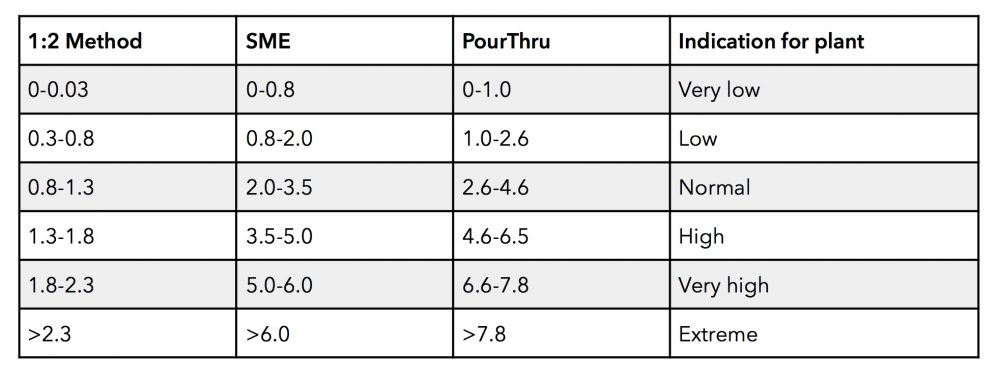Analyzing the EC
Temperature influence:
The conductivity of a solution is highly temperature dependent, therefore it is important to either use a temperature compensated instrument (ATC), or calibrate the instrument at the same temperature as the solution being measured. As the temperature of a solution increases, the mobility of the ions in the solution also increases and consequently this will lead to an increase in its conductivity. Therefore it is mandatory to always associate conductivity measurements with a reference temperature of 25º C. (standard temperature), unless otherwise qualified.
Comparing results:
There are different methods of analyzing the EC-value of potting soil. Each with its advantages and disadvantages. The more controlled and reliable, the more useful as a comparative tool, but of course the more simple and fast methods are the most easy to use in the field. To be able to make use of EC-values in regulating soil and plant life, it is very important to know that all analyzing methods have their own results, which are not interchangeable. The amount of water used to extract plant-available nutrients and other details of the analyzing methods can give large differences in results. Always use the interpretative data that match the analyzing method you used, otherwise you could make an incorrect interpretation of the results. Therefore each EC-value should always state the analyzing method to make it a useful value for the reader.
Check the soluble salt levels determined by a few of the different analyzing methods in the table:

1:2 volume method for potting soil:
In this test an air-dried sample of soil and water are mixed together in the volume ratio of 1 part soil to 2 parts water (using a measuring cup). The liquid extract is then separated from the solids using laboratory grade filter paper or a common coffee filter. The extract is then ready for analysis. This is a very easy test to master and quite suitable for on-site greenhouse testing of pH and soluble salt using the so-called pH and EC “pens” available from greenhouse suppliers. The 1:2 method is a very good choice for occasional pH and soluble salts testing by growers on-site.
PourThru method (also called drain method):
With this method, a container with medium in it is elevated above a collection vessel suitable for collecting leachate from drainage holes. Enough distilled water is added to the surface of the medium to collect 50 milliliters (ml) of leachate from the container medium. The moisture level of the container medium should be at or near container capacity before starting this method. At least 5 samples or containers should be tested.
Advantages of the PourThru method:
– extraction and analyses can be done on-site
– plants do not have to be sacrificed or disturbed for testing
– time required for extraction is short and no preparation of medium
– specialized equipment for extracting the solution is unnecessary
Disadvantage of the PourThru method is mainly a poor liability, as:
– the moisture level in the medium should be exactly similar each time
– water may channel in the medium causing erroneous results
– variety in ml. of water poured through
The PourThru Method is best used for continuous monitoring and graphical tracking of pH and soluble salts. An irrigation and leachate protocol must be established and carefully followed to make this method work best. This method is not a good choice for casual checks (use volume method for this) as the “numbers” are often quite variable, inconclusive, and probably unreliable.
Squeeze method:
With this method, irrigate the substrate with diluted water until it is thoroughly wet. Sample substrate from at least 5 plug trays and mix the sample to ensure uniformity. Place the collected sample in a paper towel (cheesecloth) and squeeze the solution from the substrate into a cup. Measure the EC directly in the extracted solution.
Advantages of the method:
– more representative as no subjective addition of the correct amount of water is involved
– extraction and analyses can be done in the field
– simple and fast
– specialized equipment for extracting the solution is unnecessary
Disadvantage of the method is mainly a poor liability, as:
– variety in water wetness of medium, gives other results
– variety in squeezing gives other results
Saturated Media Extract (SME):
In this test a saturated paste is made using a representative sample of the media and deionized water. After 90 minutes, the liquid portion (the extract) is separated (filtered under suction) from the solid portion for pH, soluble salt, and nutrient analysis. Special skills and laboratory equipment are required to perform this test. SME is probably not suitable for a grower to use, unless the greenhouse operation is large enough to support a lab, to have a technically trained person to carry out the tests, and with a commitment to frequent testing and tracking of the results.
